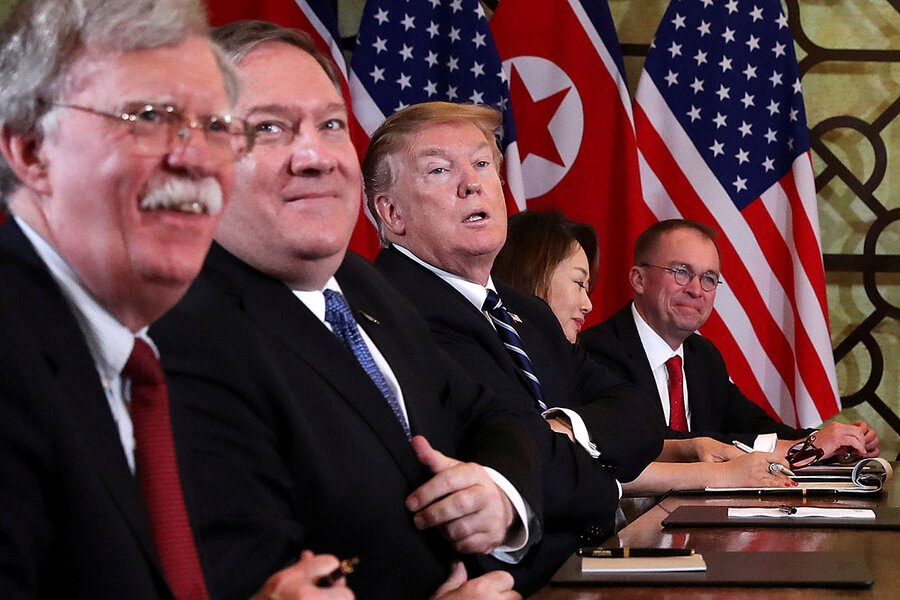Trump lowered tensions with Iran: why he had to step in
Loading...
| Washington
As Venezuela appeared last month to be on the brink of a momentous political shift, President Donald Trump’s national security team assured him that indeed the strife-torn South American country was about to take the turn to new leadership the administration had been encouraging for months.
But in the end things didn’t go as John Bolton, the national security adviser, or for that matter Secretary of State Mike Pompeo, said they would. Venezuela’s authoritarian President Nicolás Maduro maintained his hold on power.
And an unhappy Mr. Trump suggested to close friends and advisers that he felt he had been misled by his team.
Why We Wrote This
If it’s important for global adversaries to understand the language of diplomacy, a leader’s closest advisers also should agree on what to say. Recently, President Trump and his national security team seem out of step.
Now it’s tensions with Iran that have surged to their highest levels yet under the Trump administration. And once again the president is signaling discomfort with the advice and sense of heightened urgency he is feeling from his team – again led by Mr. Bolton – to go full steam toward a confrontational posture.
“John ... has strong views on things which is OK. I’m the one who tempers him, which is OK. I have John Bolton and I have people who are a little more dovish than him,” Mr. Trump told reporters last week.
This week, Mr. Trump reportedly used a White House national security meeting to tell acting Defense Secretary Patrick Shanahan he doesn’t want a war with Iran – and to send a message to others in the room.
Privately, some administration officials say, the president has even groused to friends and advisers that Mr. Bolton and his underlying and long-held preference for regime change in Iran could lead to the Middle East war he has pledged to avoid since the 2016 campaign.
The White House’s Iran tumult underscores an intensifying clash of strategies for addressing the challenges that the Islamic Republic poses to the United States and its allies in the region. And as with Venezuela, the Iran debate has laid bare the discomfort Mr. Trump seems to be experiencing with a team that in some ways is out in front of him – and has misled him before.
North Korea parallels
The spike in tensions with Iran parallels in many ways where the Trump White House was with North Korea in the months that led up to Mr. Trump’s groundbreaking Singapore summit with North Korean leader Kim Jong Un in June 2017, some regional and Iran policy analysts say.
And they note that the North Korea model of rhetorical fire and fury leading to talks with an avowed adversary is the strategy Mr. Trump appears to favor with Iran as well.
“The North Korea scenario is absolutely what we’re seeing here, in that the president is essentially envisioning a North Korea process with the Iranians that leads to negotiations, even without preconditions,” says Ilan Berman, vice president of the American Foreign Policy Council, a Washington foreign policy think tank, and an expert in Middle East regional security.
But at the same time, the president’s favored route faces competition from two alternative approaches, Mr. Berman says. He boils those down to the “regime collapsers” – Secretary Pompeo and others who prefer strangling the Iranian regime with ever-tougher sanctions and other harsh diplomatic measures – and the “regime-changers” favoring military force, led by Mr. Bolton.
Mr. Trump has gone along with ratcheting up sanctions on Iran to get to negotiations – a route he also took with North Korea – ever since he pulled the U.S. out of the Iran nuclear deal last year. But he has sent multiple signals he is much more wary of the rush to military conflict implicit in the Iran regime-change option.
Indeed, there may have never been a president and a national security adviser “less alike” as Mr. Trump and Mr. Bolton, says Karim Sadjadpour, expert in U.S.-Iran relations at the Carnegie Endowment for International Peace in Washington.
Analysts note it was a statement issued by Mr. Bolton, and not a presidential tweet, that announced last week the dispatch of an aircraft carrier strike group and Air Force bombers to the Persian Gulf. While the deployment was previously scheduled, Mr. Bolton characterized its timing as a response to “troubling and escalatory indications and warnings” coming either from Iran or from its proxies.
Moreover, Defense Department officials say it was in response to requests from Mr. Bolton that the Pentagon had provided the White House with a variety of options for confronting Iran in the event it attacked U.S. forces in the region or ramped up its dormant nuclear program. One scenario called for the deployment of 120,000 U.S. troops – about the number sent in the initial stages of the Iraq War that topped Saddam Hussein.
Mr. Trump considers that war a “disaster,” while Mr. Bolton, who served President George W. Bush and was a fervent hawk on Iraq, stands by the decision to launch a war.
Frustration on both sides
Neither Mr. Trump nor the Iranian leadership profess to want war, but at the same time both sides are frustrated with the status quo, some analysts say.
“The big spike in tensions we’re seeing right now is a reflection of both Iran and the United States feeling that time isn’t really on their side,” says Alex Vatanka, a senior fellow in Middle East regional security specializing in Iran at the Middle East Institute in Washington.
“On the U.S. side, the Trump administration had hoped that by now the devastating sanctions imposed on Iran would have had some success with the intended regime behavior modification, and would had worked in bringing them back to the negotiating table,” Mr. Vatanka says.
As for the Iranians, “They are increasingly worried about the prospects of the state of affairs they are facing – with these historic, powerful sanctions – becoming the new normal,” he adds, “and they feel they can’t allow that to happen.”
Mr. Vatanka says that helps explain a variety of actions the Iranians have taken recently, targeting the Europeans but also regional adversaries such as Saudi Arabia and Israel that the Iranians consider to be the “B team” to Washington.
“They’re letting people know that ‘If we’re going to suffer, others are going to come along and suffer as well,’” he says.
That “suffering” has ranged from letting the European signatories of the nuclear deal know that Iran will curtail its efforts to stem the flow of drugs and refugees from Afghanistan into Europe if the Europeans cooperate with the U.S. on renewed sanctions, Mr. Vatanka says, to a recent drone attack on a Saudi oil pipeline.
U.S. intelligence agencies also recently detected what they said was evidence of the Iranians loading missiles onto ships patrolling the Persian Gulf. Moreover, intelligence operatives in Iraq recently reported evidence of Iranian proxy groups stepping up activity – including moving in missiles – around U.S. diplomatic installations in Iraq. That intelligence prompted the State Department this week to partially shutter the embassy in Baghdad and the consulate in Erbil in northern Iraq.
It is this kind of “provocation” that Mr. Bolton is responding to in issuing his tough words. But despite the national security adviser’s reputation as a regime-changer, some analysts believe the model he has in mind in the current sparring with Iran is not so much the Iraq War as a limited military operation that could stun the Iranian regime into accepting talks.
The model for such a military offensive might be the limited operation President Ronald Reagan launched in 1988 in response to Iran’s mining of the Persian Gulf, threatening the passage of oil tankers, some analysts say. Operation Praying Mantis resulted in the destruction or disabling of about half of Iran’s naval fleet – without, the analysts note, setting off a full-scale war.
But getting the Iranian regime to the negotiating table with President Trump is likely to be even tougher than pulling off the Trump-Kim rendezvous, most analysts say. The Iranians would need a means of saving face – their economy reeling and Mr. Trump long since established as the boogeyman – before sitting down with the Trump administration.
Pompeo’s 12 points
Moreover, the conditions Secretary Pompeo set a year ago for the U.S. making peace with Iran in a Washington speech – the famous 12 points Tehran would have to meet before shedding its rogue-regime status – are seen by the Iranians as regime change in disguise, and indeed go well beyond anything demanded of North Korea’s Mr. Kim.
“At the end of the day, the Iranians might find a way to bite the bullet” and sit down to talks, Mr. Vatanka says. “But Pompeo’s 12 points are a non-starter,” making talks with the U.S. of Mr. Trump “much harder than when they talked with the Obama administration,” he adds. “This would not be about the optics, it would be about de-escalation.”
The question now, some analysts say, is whether the Iranians decide to wait out the Trump administration in hopes of a less hostile replacement, or if they decide to “bite the bullet.”
“The question is, will [the Iranians] just grit their teeth and try to tough this out … or do they actually come to the table sometime next year and say, ‘Hey, let’s talk about this?’” said retired Gen. David Petraeus, former CIA chief, at a recent discussion in Washington.
Indeed, some experts believe Iran is interested in finding a way to launch a dialogue with Washington. But they note that while the president has spoken publicly and privately of sitting down with the Iranians, Trump administration officials are not believed to have sent feelers to Tehran in the midst of the all-pressure-all-the-time campaign.
At the same time, they note that the Trump White House lacks a direct channel to Tehran, of the sort the Obama administration had during secret talks with Iranian officials, with Oman and Switzerland acting as go-betweens.
Mr. Berman of the American Foreign Policy Council describes the Trump administration strategy toward Iran as “very much front-loaded,” with all of the focus on means of pressuring Tehran to modify its behavior.
Less thought has been given to the goals the administration wants from launching an engagement process with Iran – one he says would be considerably more complicated and lengthy than the one with North Korea.
What the basis of a process won’t be, Mr. Berman says, is Mr. Pompeo’s 12 points. “However you rack and stack those 12 demands, they look an awful lot like capitulation,” he says. “And I don’t think that’s conceivable on the Iranian side.”







